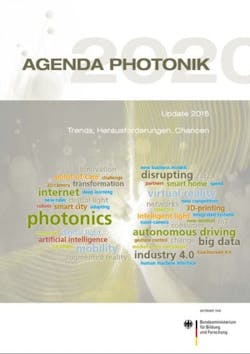Photonik 2020—Germany’s multi-billion-euro photonics agenda updated

In 2010, 300 German industry representatives started a strategy process to find out what they could do to ensure a leading position in six fields related to photonics. They promised to spend €30 billion for R&D in Germany until 2020, a challenging rate of 10% of the €300 billion revenue they expected from photonics technologies over those ten years.
Furthermore, they submitted a document on trends and needs in the photonics industry to the German Federal Ministry of Education and Research. Two years later the German government started a complex funding initiative for photonics-related projects with a budget of 1 billion euros over 10 years.
The process actually started with the famous American report from 1998, “Harnessing Light, Optical Science and Engineering for the 21st Century”, and, throughout the years, several countries developed or updated their own strategic agendas for photonics. The United States launched the National Photonics Initiative in 2013, and Asian countries such China, Korea, and Japan started and updated their activities even more frequently, as a detailed survey from Germany shows.
It’s all connected
In 2016 the German program committee for the photonics agenda arranged a series of six workshops to review and update the agenda targets. In December the results were presented by Peter Leibinger (vice chairman of TRUMPF) at the CODE-n festival in Karlsruhe. Now a printed report has been issued that gives some interesting insights into the strategy of the German photonics industry.
The updated report highlights six fields of photonic technologies with need for action:
• Connected light: Intelligent lighting solutions from smart homes to smart cities
• Light and mobility: Photonics in cars
• Consumer photonics: Photonics for consumer markets
• Man-machine-production: Flexible and connected manufacturing for Industry 4.0
• Photonics in healthcare: Life science and environmental analytics
• Light connects: Photonics for information and communication technology
Ten years ago the main topics looked like this:
• Production and mechanical engineering
• Life science and healthcare
• Communication and information technology
• Illumination and energy
• Organic electronics
• Emerging technologies
In the 44-page update each of the six fields is broken down to a longer list of suggested needs for changes and funding opportunities. It is tough to go through all details but still, one may see a few interesting changes. While major topics such as healthcare and communication/information remained in place, two other topics came up with almost highest priority.
The first is connectivity in manufacturing. In Germany it is summarized as Industry 4.0, and stands for substantial productivity gains through a complete restructuring of manufacturing processes based on automation and extended data exchange. Here, machines become cyber-physical systems that communicate and cooperate with each other and with humans in real time. This new wave of smart factories sparks hope that production facilities may stay or even return to Germany, if fewer but highly qualified workers are needed.
Eyes turn to consumer markets
A second interesting topic is a stronger priority for consumer markets. German industry is famous for its capital equipment, but for the future it may need to turn its focus on the end customer. For example, in automotive markets Germany still holds major parts of the value chain whereas it delivers only equipment and technology for smartphones.
For more success in consumer markets, more international partnerships and a change in the (German) mind set are required: It’s not sufficient anymore to make the best machine in the world. It is necessary to shorten development cycles and to enable a faster adoption of new ideas and to partner in early development stages. Usability should be a bigger topic, and it should be considered much earlier in development—and even in the academic education of engineers and physicists.
Things to watch in coming years
After all, this report is coming from the photonics community and their stakeholders in industry and academia. It is dedicated to the German funding agencies. With several dozens of sub-topics it will be a blueprint of funding areas for the next years.
The main topics from the original agenda remain in place, but several new cross-cutting issues are added that relate to almost all fields. For example, integrated photonic systems are coming in all fields from manufacturing to healthcare and consumer markets. Image data acquisition and processing will speed up with data processing near the sensor. Man-machine-interaction will become common place with machines recognizing humans in a holistic way.
The vision remains unchanged: all these technological challenges are pieces that will make up the technological base for future photonic solutions for many fields of the economy and society. And the German photonics community is ready to take up these challenges (with appropriate funding).

Andreas Thoss | Contributing Editor, Germany
Andreas Thoss is the Managing Director of THOSS Media (Berlin) and has many years of experience in photonics-related research, publishing, marketing, and public relations. He worked with John Wiley & Sons until 2010, when he founded THOSS Media. In 2012, he founded the scientific journal Advanced Optical Technologies. His university research focused on ultrashort and ultra-intense laser pulses, and he holds several patents.
